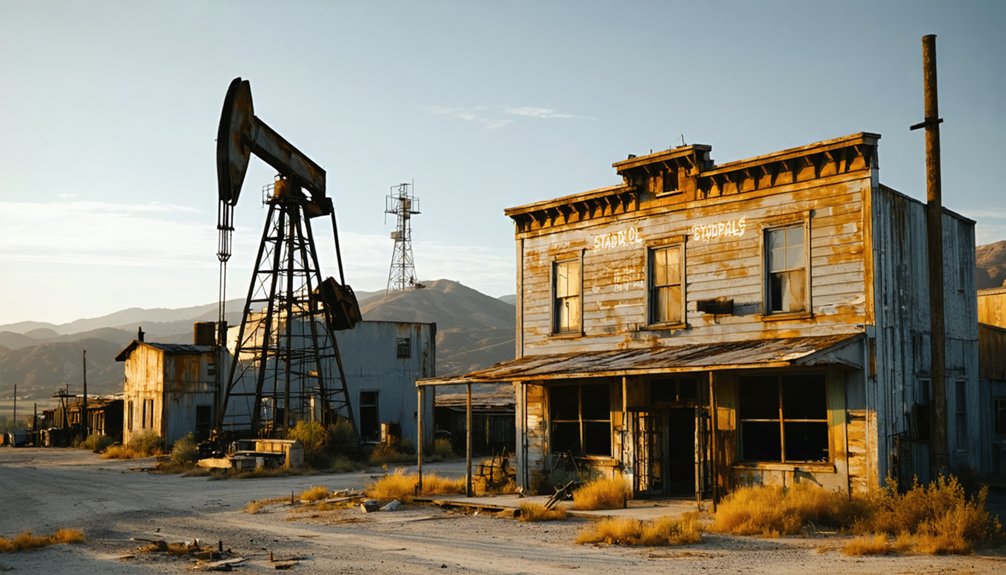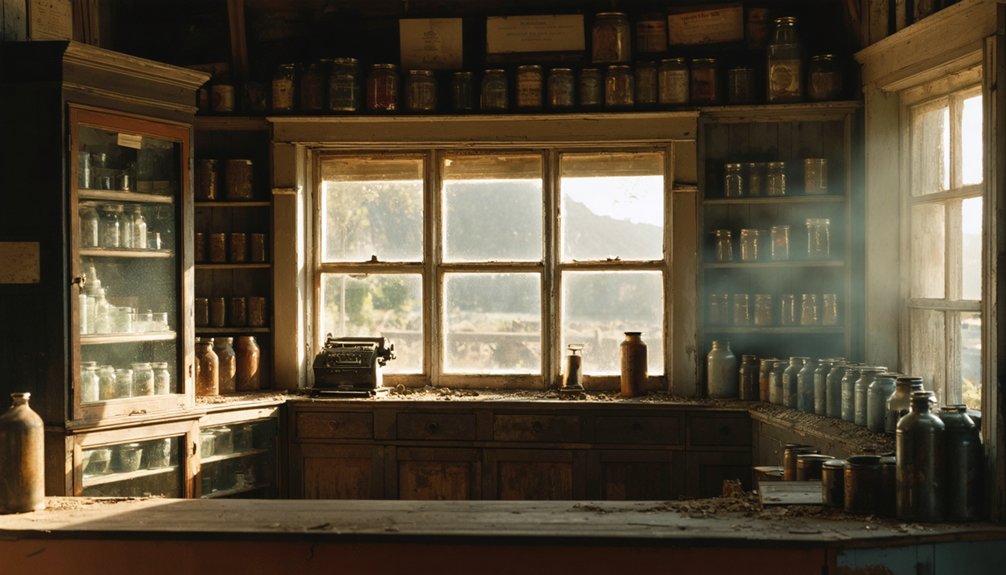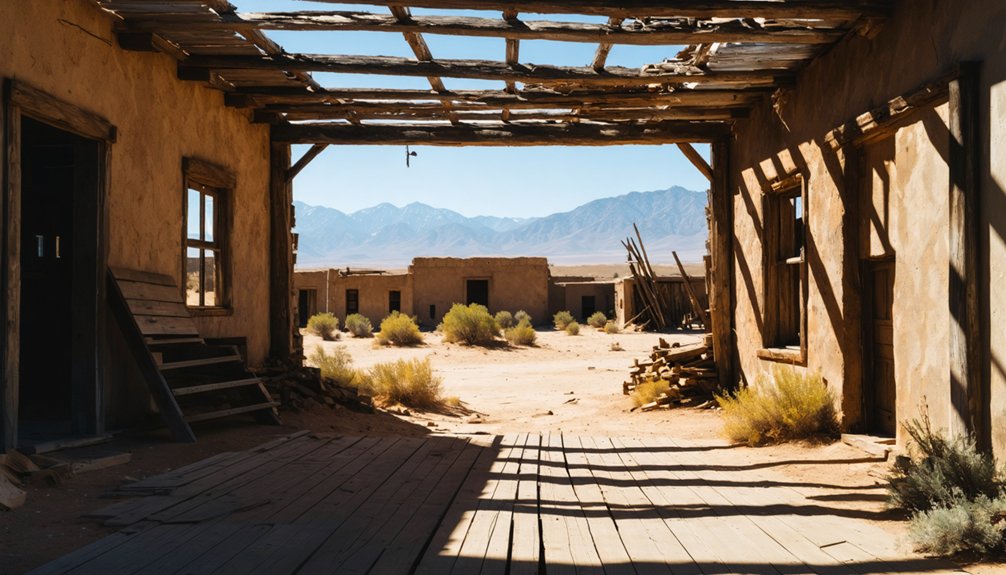Shale, California was a boom-and-bust mining town in the Mojave Desert, thriving on salt extraction in the early 1900s. You’ll find it peaked around 1915, producing 720 tons of salt weekly with up to 65 workers. Company-owned housing, a store, post office, and schoolhouse formed this isolated community. By 1975, nature had reclaimed the settlement after drought, declining salt quality, and economic hardship led to its abandonment. The skeletal ruins tell a haunting tale of desert prosperity.
Key Takeaways
- Shale was a California mining town that flourished in the early 20th century due to valuable salt deposits discovered in the Mojave Desert.
- The town followed a typical boom-bust cycle, peaking with 65 workers producing 720 tons of salt weekly in 1915.
- As a company town, residents lived in corporate-owned housing near the mine and depended entirely on the company store.
- Water scarcity in the harsh Mojave Desert climate contributed significantly to Shale’s eventual decline and abandonment.
- Today, only ruins remain, including skeletal structures and mining infrastructure that represent California’s frontier mining heritage.
The Birth of a Mining Settlement
When prospectors first stumbled upon the valuable mineral deposits that would give birth to Shale, California in the early 20th century, they couldn’t have imagined the brief but intense boom that would follow.
You can almost picture them staking their claims, their eyes gleaming with the promise of cannel coal and oil shale worth up to $3 per pound.
Driven by the Hardrock Mining Law and minimal federal oversight, miners swarmed the area.
Mining techniques evolved rapidly as the settlement grew to house thousands.
Infrastructure sprouted from the wilderness—ore processing mills, supply stores, and roads connecting to distant railroads.
Pack mules navigated treacherous paths, hauling precious cargo from inaccessible mines.
The settlement’s rise coincided with the first western oil shale boom when approximately 100 new companies formed to mine and process oil shale in similar regions.
Claims proliferated rapidly across the Western Slope, with millions of acres staked by eager prospectors by 1920.
Today, this once-bustling hub stands as a haunting ghost town, silent testimony to America’s resource-driven westward expansion.
Life in the Mojave: Shale’s Desert Environment
You’d have found life in Shale constantly shaped by the Mojave’s relentless climate, with summer soil temperatures reaching a scorching 71°F and the rain-shadowed landscape offering precious little rainfall.
Your survival would’ve hinged on accessing the scarce groundwater sources, often laden with high concentrations of dissolved solids and chloride that made water quality a persistent struggle. The thermic soil regime typical of the Mojave created challenging conditions for any attempts at local agriculture. The extreme temperature variations meant residents endured freezing winters and summer temperatures exceeding 100°F, making daily life a constant battle against the elements.
The rare natural springs in the region, similar to those at Ash Meadows, would’ve been coveted lifelines for the mining community, their precious waters determining whether Shale’s residents thrived or merely endured in this harsh desert environment.
Harsh Climate Challenges
Living in Shale meant confronting the Mojave Desert’s merciless climate, a natural force that shaped every aspect of daily existence.
You’d awaken to scorching summer days exceeding 100°F, only to shiver through winter nights that plunged below freezing. Temperature swings of 40°F within a single day weren’t uncommon.
Your climate resilience strategies necessarily evolved with the seasons. With less than 10 inches of annual rainfall—most arriving in just a few brief storms—water conservation became second nature. This struggle with the elements was particularly challenging, as the region typically received only 2 to 6 inches of precipitation annually.
The landscape surrounding the town featured characteristic sedimentary hills with steep slopes between 30 to 75 percent, creating a dramatic backdrop to daily life.
You’d learn desert survival techniques passed down by those who’d weathered these conditions before you: when to expect the dry months of May and June, how to prepare for sudden flash floods, and ways to shield yourself from the relentless winds that swept across the valley floors.
Water Sourcing Struggles
Water, the desert’s most precious commodity, proved nearly impossible to secure in Shale’s harsh Mojave environment. You’d find no rivers flowing into Koehn Lake—just a terminal basin where water evaporated, leaving behind nothing but salt and broken dreams.
The mining operations resorted to pumping water artificially, an expensive gamble that ultimately failed. When rainfall blessed the region, salt production thrived, but during inevitable dry spells, everything ground to a halt. Gypsum influx during drought periods further contaminated the salt deposits, reducing pure salt production.
This water scarcity directly shaped the community impact. Few families could establish permanent roots; schools remained sparsely attended. The situation mirrored what happened in Owens Valley, where water diversion destroyed the environment and community. As water dwindled, so did population. You’d witness residents traveling great distances for basic needs, their very existence dependent on each precious drop.
Saltdale and Shale rose briefly, then withered under the Mojave’s unforgiving thirst.
Mining Operations and Resource Extraction
You’ll find that Shale’s history paralleled California’s tumultuous relationship with resource extraction, where early operations mirrored the same boom-bust cycle that plagued the Monterey formation developments.
The town’s economy surged briefly during peak extraction years, with miners utilizing similar retorting technologies to those pioneered along the Ohio River Valley in 1857. Companies like Occidental Petroleum and Oxy were among the major operators exploring various extraction strategies in the region. The regulatory environment following the Santa Barbara oil spill of 1969 significantly impacted extraction operations throughout California, including in Shale.
When oil prices collapsed in the early 1980s, Shale’s fate was sealed as operations became commercially unviable against cheaper imported crude, leaving behind abandoned infrastructure as silent testimony to resource depletion.
Mineral Extraction Processes
When you explore the remnants of mineral extraction in Shale, California, you’re witnessing the evolution of a once-thriving industry that shaped this now-ghostly landscape.
The early 1900s brought primitive shale extraction methods to this region, with surface retorts and open-pit operations dominating the scene.
You’ll notice traces of deep shafts and horizontal tunnels where workers once navigated the fractured Monterey formation, rich in chert and dolostone.
Companies like Texaco and Union Oil transformed these hills between 1918-1930, applying increasingly sophisticated techniques to tap the complex carbonate-rich deposits.
The natural fractures in the shale provided pathways that later operations would exploit through hydroretorting and early hydraulic fracturing attempts.
This mineral economy boomed briefly before technical limitations and falling oil prices ultimately silenced the extraction machinery forever.
Economic Boom-Bust Cycle
While the mineral extraction technologies reveal the technical side of Shale’s story, the economic forces behind this ghost town paint a more human picture of ambition and abandonment.
You might recognize Shale’s arc from similar California ghost towns—a swift ascension followed by inevitable decline.
Like Saltdale, which boomed when salt mining operations extracted 700+ tons weekly from Koehn Dry Lake, Shale flourished briefly before environmental and market forces intervened.
As rainfall patterns shifted, salt deposits diminished, and modernization reduced labor needs from 65 workers to just three by 1949.
The company town’s wooden houses emptied as families sought work elsewhere.
With the mill’s closure by 1975, nature reclaimed what humans had built.
Shale’s story reflects the fragile foundation of single-resource economies—promising freedom and prosperity until the earth stops giving.
Daily Existence for Shale’s Residents
Tucked away among the arid expanses of California’s desert, Shale’s daily existence revolved entirely around the salt mining operations that gave the town its purpose.
You’d start your day heading to the four-story mill, where salt production peaked at 720 tons weekly in 1915. After shifts extracting salt from Koehn Lake, you’d return to your company-owned wooden house.
Life wasn’t all work—community gatherings like dances and picnics provided essential relief from isolation. You’d shop at the company store, mail letters at the post office established in 1916, and send your children to the small schoolhouse built after 1920.
Southern Sierras Power Company brought electricity in 1919, modernizing your modest home.
The Company Town Structure

If you’d visited Shale during its heyday, you’d have found yourself residing in one of the company’s uniform housing units, built within walking distance of the oil shale operations that employed nearly everyone in town.
Your entire economic existence would have revolved around the company—from the paycheck you earned to the rent you paid and the goods you purchased at the company store.
The corporate ownership created a self-contained ecosystem where your livelihood, shelter, and daily necessities all flowed through the same hands that controlled the mining operations.
Corporate Housing Design
Although minimal historical records remain about Shale’s corporate housing design, the company town structure followed patterns typical of early 20th century industrial settlements throughout California’s resource extraction regions.
The corporate architecture likely reflected a utilitarian philosophy—simple wooden structures arranged in grid-like formations around the central production facilities.
You’d have noticed a distinct housing hierarchy as you walked through Shale’s streets. Executive dwellings stood separate from worker cottages, with supervisors’ homes creating a buffer zone between labor and management.
The housing layout reinforced social stratification while maximizing efficiency.
Unlike the personalized homes you’d find in organically developed communities, Shale’s buildings exhibited standardized designs—practical, affordable, and quickly constructed.
This uniformity created a landscape where your status within the company determined your living conditions, a visual reminder of the industrial power structure.
Self-Contained Worker Economy
The economic lifeblood of Shale flowed entirely through company channels, creating a closed system where your paycheck might never leave corporate hands.
You’d earn your wages mining salt from Koehn Lake, then spend them at the company store for necessities—a circular arrangement ensuring company control over both production and consumption.
With only 30-65 workers at its peak, Shale’s economic interdependence was unavoidable.
The weekly salt shipments of up to 250 tons determined everyone’s fortunes. When salt purity faltered or gypsum contaminated the harvest, your livelihood immediately suffered.
The company-run gas station, grocery, and post office created the illusion of a normal town, but the reality was stark: when the salt declined, the economic structure collapsed completely, leaving nothing to sustain the community that once thrived there.
Transportation and Connection to Civilization
Lifelines of isolation, transportation networks served as critical arteries connecting ghost towns like Shale to the wider world during their brief existence.
The ghost town dynamics reveal a settlement’s prosperity hinged entirely upon its accessibility to resources and markets.
Transportation evolution in these desert outposts followed four distinct patterns:
- Railroad dependence – Steam engines required strategic water stops, creating communities like Kelo that thrived until technology evolved.
- Wagon routes – Six-horse teams hauled precious water at $4 per barrel to parched mining camps.
- Aerial innovation – Gravity-powered tramways like Cerro Gordo’s 5.6-mile system revolutionized ore transport.
- Highway bypassing – Route realignments sealed the fate of once-bustling communities.
You’re witnessing the remains of a freedom-seeking society whose lifelines were severed when transportation networks shifted, leaving only memories in the desert dust.
Peak Years and Economic Prosperity

During the early decades of the twentieth century, Shale transformed from a dusty outpost into a bustling hub of economic significance, driven primarily by the region’s abundant salt deposits.
You’d have witnessed Shale at its zenith in the 1910s when the Consolidated Salt Company extracted nearly 250 tons weekly. The post office’s 1916 opening marked official recognition of the growing settlement.
With 65 workers at its peak, the community flourished around salt production, establishing schools, stores, and regular social gatherings.
Mining technology evolved to efficiently harvest the lakebeds, with a small-gauge railroad connecting operations to main rail lines. This prosperity created a brief but vibrant period where residents enjoyed unexpected comfort in the harsh desert environment.
Though short-lived, Shale’s legacy as a significant salt producer endured, demonstrating how ingenuity could transform barren landscapes into centers of industry.
Signs of Decline: When the Boom Ended
While Shale’s golden era seemed destined to continue indefinitely, signs of trouble began appearing by the early 1940s when a persistent drought settled over the region, fundamentally altering the town’s fortunes.
The mining legacy that built Shale began crumbling as environmental forces conspired against the community’s resilience.
You’d have witnessed this decline through:
- The shuttering of the post office in 1950, severing crucial communication links
- The school district’s closure in 1951, signaling the exodus of families
- Abandonment of the company store, eliminating access to fundamental goods
- Deterioration of railroad infrastructure, isolating the remaining residents
What Remains: Exploring Shale’s Ruins Today

Tucked away in the unforgiving California desert, Shale’s ghostly remnants stand as silent witnesses to a once-thriving community that time has nearly forgotten.
As you venture across this weathered landscape, you’ll discover skeletal wooden structures—former homes, a company store, and the crumbling schoolhouse foundation—all slowly surrendering to the elements.
Ruin exploration here reveals fascinating historical artifacts: scattered glass bottles, rusted mining equipment, and household items that tell stories of daily life.
You’ll trace rusted rail tracks to abandoned mine shafts and see massive tailings piles that testify to the town’s industrial past.
Be prepared for true wilderness adventure—the site demands high-clearance vehicles and self-sufficiency.
With no visitor center or amenities, you’ll need water, supplies, and navigation tools to safely witness this fading chapter of California history.
Preserving the Memory of Forgotten Boomtowns
As small frontier settlements like Shale vanish into the desert landscape, preservation efforts have become essential in maintaining California’s rich mining heritage for future generations.
These forgotten boomtowns carry immense historical significance that extends beyond crumbling structures—they embody the pioneering spirit that shaped the West.
To honor Shale’s community legacy, preservation initiatives focus on:
- Documenting oral histories from descendants of original settlers before these firsthand connections disappear
- Creating digital archives that capture Shale’s unique contribution to California’s mining narrative
- Establishing protected status for remaining structures to prevent further deterioration
- Developing educational programs that connect modern visitors with the town’s authentic frontier experience
You’ll find that these preservation efforts aren’t just about saving buildings—they’re about keeping alive the stories of freedom-seeking individuals who once called Shale home.
Frequently Asked Questions
Are There Any Surviving Descendants of Original Shale Residents?
With only 30-65 workers at Shale’s peak, no documented descendant stories exist. You won’t find organized family connections or genealogical records tracing original residents after the town’s 1950s abandonment.
What Supernatural Legends or Ghost Stories Surround Shale?
You’ll find Shale’s haunted history surprisingly bare. Unlike neighboring towns, there’s no record of ghost sightings here. The whispers of supernatural legends have bypassed this forgotten mining outpost entirely.
Can Visitors Legally Collect Artifacts From Shale’s Ruins?
No, you can’t legally collect artifacts from these ruins. Legal regulations protect Shale as federal BLM land. You’ll cherish history better through photographs while respecting artifact preservation laws that safeguard our collective past.
Were Any Notable Films or Photographs Taken in Shale?
Like searching for gold in an empty stream, you’ll find no remarkable film history or photography significance in Shale. Records don’t show any notable films or artistic photographs taken there.
Did Shale Experience Any Significant Natural Disasters During Its Existence?
You’d have found your ancestors battling earthquake impacts that cracked the town’s foundation and flood consequences that washed away homes, leaving behind only whispered stories of nature’s untamed fury.
References
- https://www.vvdailypress.com/story/lifestyle/2022/02/03/california-mojave-desert-ghost-towns-exploring-saltdale-salt-flats-netflix-worthy-travel-destination/9305051002/
- https://www.sfgate.com/travel/article/saltdale-ghost-town-vanishing-18591851.php
- https://www.nps.gov/deva/learn/historyculture/death-valley-ghost-towns.htm
- https://lonepinechamber.org/history/ghost-towns-of-the-lone-pine-area/
- https://www.youtube.com/watch?v=OD9M6MP6RRU
- https://whimsysoul.com/must-see-california-ghost-towns-explore-forgotten-histories/
- https://www.youtube.com/watch?v=Q_yjBgICWl8
- https://en.wikipedia.org/wiki/List_of_ghost_towns_in_California
- https://en.wikipedia.org/wiki/History_of_the_oil_shale_industry_in_the_United_States
- https://www.mulemuseum.org/uploads/6/8/0/4/68049983/white_mountain_mining_history_with_maps_and_tables-2.pdf



